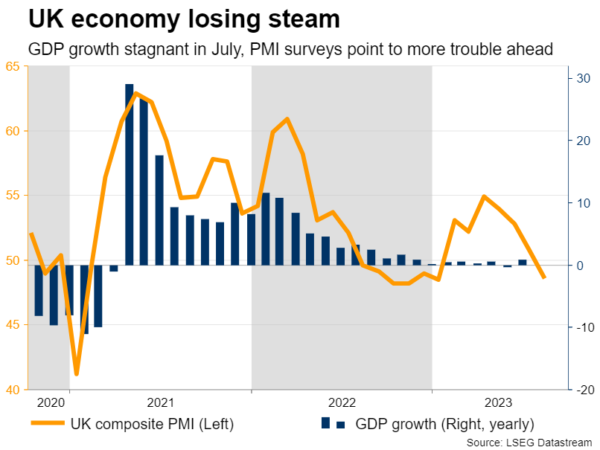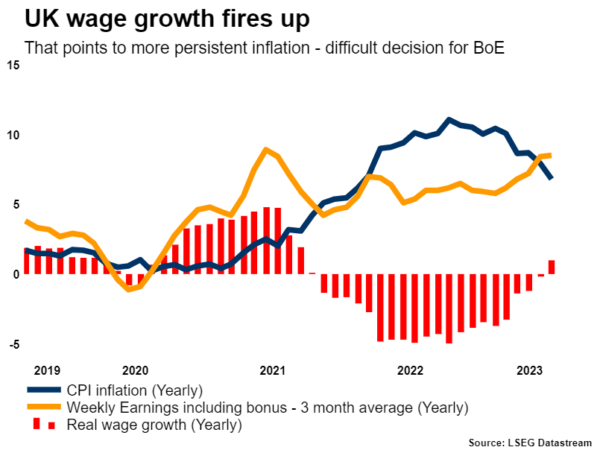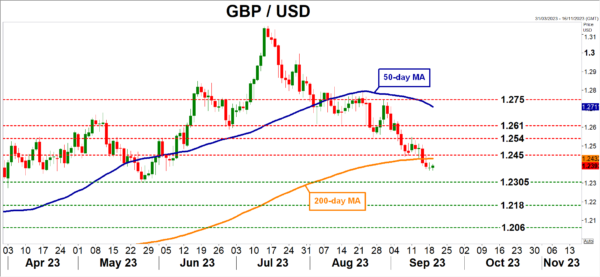- Bank of England set to raise interest rates this week
- Mixed economic data, so commentary could be cautious
- Risks for British pound seem tilted to the downside
- Decision expected at 11:00 GMT on Thursday
Weaker data pulse
The United Kingdom economy seems to be losing steam, with recent data releases showcasing a severe slowdown in growth and a softer labor market. Economic growth was stagnant in July from a year earlier and business surveys warn the situation will get worse, putting the risk of a minor recession on the radar.
Employment data have already started to reflect this weakness. The labor market lost jobs in July, pushing the unemployment rate higher. Open job vacancies declined as well, which is a sign that labor demand has started to soften. Hence, employment trends are moving in the wrong direction and this phenomenon is likely to persist according to leading indicators.
The problem for the Bank of England is that wage growth is already hot and continues to accelerate. Including bonuses, wage growth is running at 8.5% in annual terms. That suggests inflationary pressures are unlikely to cool anytime soon, and the recent rally in oil prices reinforces this notion.
BoE dilemma
As such, the BoE has a difficult decision to make. Raising rates even higher would help to bring inflation under control, but it would also dampen economic growth further, pushing the economy off the cliff towards a recession.
Market pricing points to an 80% probability of a rate increase this week, which is justified since recent remarks by BoE officials reveal a preference for further tightening. Nonetheless, it could be a closer call than investors expect. The vote count is likely to be split, with some policymakers favoring no action instead, following the streak of worrisome data.
Most importantly, the forward guidance might not include a commitment to any further action. There’s a strong possibility the BoE signals this is the peak in interest rates already, similar to what the ECB did last week. Several policymakers including chief economist Huw Pill have indicated they would rather keep rates steady for a longer period of time, rather than raise them much further.
Therefore, the statement is likely to strike a cautious tone. Since this is one of the smaller meetings without updated economic forecasts or a press conference, this is where the market action will come from. Note that the nation’s inflation numbers for August will be released on Wednesday ahead of the meeting and could influence the decision. The latest business surveys will follow on Friday.
Lose-lose scenario for sterling?
Turning to the market reaction, the risks surrounding the British pound from this meeting seem tilted to the downside. If the BoE raises rates, the currency could initially spike higher. However, any upside reaction might be relatively small since this is the market’s baseline scenario already, and reverse quickly if there’s no clear commitment to any further hikes.
That’s what happened to the euro after last week’s ECB decision, and the pound could suffer a similar fate as traders begin to speculate that the tightening cycle is over. And if the BoE doesn’t raise rates, that would come as a shock given current market pricing, pushing the pound lower immediately.
Looking at the charts, Cable has been moving lower for two months now, falling below some key moving averages. The most important area to watch on the downside is 1.2300, as any violation of this region could turn the technical picture more negative. On the upside, any advances could stall near the 1.2450 zone, which has served both as support and resistance this year.
Beyond the BoE decision, the overall trajectory of the pound will also depend on how stock markets perform, given the currency’s sensitivity to global risk sentiment.















